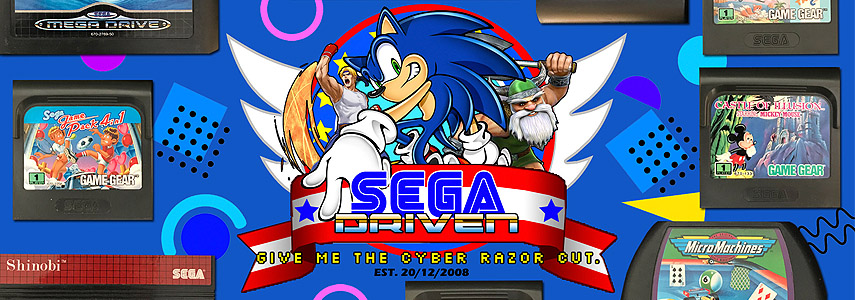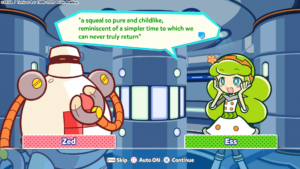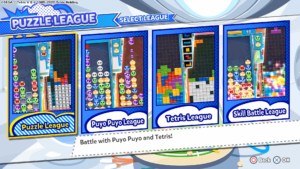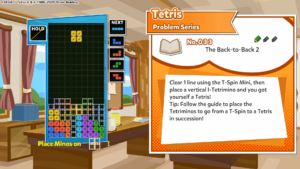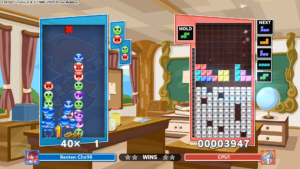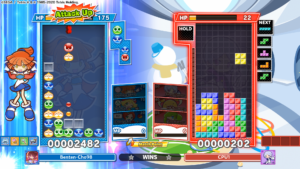Puyo Puyo Tetris 2: The Ultimate Puzzle Match – PS4 Review
Puyo Puyo Tetris 2 is a bit of an odd one to review, at a glance. The moment the game was announced, there was confusion as to how exactly you could make a worthwhile sequel to a concept as basic as “Puyo Puyo, and also Tetris.” Indeed, besides the brand new storyline in the game’s adventure mode, this game certainly boils down to more of Puyo Puyo Tetris. The additions seen here, many of them subtle, add up to create what is, on paper, a far more definitive package for both Puyo and Tetris fans, but it’s also one that also fails to address the most egregious flaws those fans found with the original game.
At its core, the foundation is the same. Puyo Puyo Tetris 2 allows you to play Puyo Puyo and Tetris in a variety of ways; the notoriously unbalanced Puyo vs Tetris, regular Puyo vs Puyo or Tetris vs Tetris, and a frankly enormous slew of other modes. For regular Versus Play, Puyo and Tetris seem to be roughly the same as ever, at least as a casual onlooker; we’ve seen reports from the die-hard Puyo fanbase that game speed may have been tweaked in some way, but the core gameplay seems to be mostly what you’d expect. I don’t think many expected the fundamental rules of Puyo and Tetris to change dramatically – the games, which may be just as spectacular as 해외배팅, are both over 30 years old, after all – but as we mentioned, the Puyo vs Tetris matchup has been seen as weighted against Puyo players for many years now (to the point it became a community meme surrounding the original), and so perhaps the greatest puzzle featured in Puyo Tetris 2 is neither Puyo or Tetris, but rather how this didn’t change. In fact, it may have actually gotten worse.
One of the areas this balance issue was most apparent to me was Swap Mode, in which you play Puyo Puyo and Tetris simultaneously and ‘swap’ between them. My strategy here was just to line up whatever decent set of Tetrises I could, and then fire them all off just as it switched to Puyo Mode to rain Garbage on my opponent instantly. This certainly brought to light the somewhat bizarre balance, as the reverse barely works and if anything, can give your opponent more ammo with which to make Lines (since Tetris garbage comes from below and only has one gap that the Tetris player must fill to clear the entire line of it). This is, to my understanding, the core of the issue with balancing both Puyo and Tetris. A good Puyo player can still easily take a bad Tetris player (such as myself) to the cleaners with little fuss, but there’s no real denying that for players of each respective game on even footing, the Tetris player has the advantage.
Moving on, there’s Party Mode, which is essentially Versus Mode with extra items. Making chains or lines that connect to item blocks will trigger them, causing an array of positive or negative effects for either you or your opponent. You might remove their ability to rotate pieces, or limit their view of the board for a short while. Here, the game only ends when the timer hits 0, and you can’t end the game by hitting the top of the board; it’ll simply give you a clean one to do-over, but that’s not exactly scoring you any points. The player with the most points by the end wins. It’s a simple idea, but executed relatively well and harkens back somewhat to the style of Puyo Puyo~n’s varied block types, with a visual presentation that reminds us of Bomberman of all things.
Fusion Mode and Big Bang also return. The former has you placing Puyo and Tetris blocks at the same time, no swapping involved, and can best be described as a mess. Which sounds bad, but it can be somewhat fun due to how strange it all is. Things feel like they move notably quicker in this mode, with the downtime between sets of Puyos or Tetriminos reduced to practically zero. This can lead to a few misplaced pieces, but on the whole this felt like even more casual fun than Party Mode did. At one point I spent 2 hours just messing around here, and despite the fact I was constantly losing to the AI, it was gratifying seeing the chaos unfold on screen. Big Bang Mode is the same as ever, taking the form of rapid-fire Puyo Fever Mode style puzzles that you have to solve as quickly and consistently as possible to defeat your opponent. Even as someone who’s better at Puyo than Tetris, it felt like I was in a much better position playing Tetris in this mode. The solutions to the problems in the Tetris side are extremely blatant compared to Puyo (though the Puyo faithful may scoff at me for that one). Being able to hard-drop Puyos at least allows those on that team to keep up with all the Tetris line-making somewhat.
Challenge Mode offers single-player takes on both included games. The obvious Marathon mode is included for Tetris, as well as Endless Puyo. Also available are Endless Fever, essentially a solo version of Big Bang, Sprint for clearing lines as quickly as you can, Tiny Puyo for people who’re after some ironically large Puyo chains, and Ultra for clearing lines as quickly as you can, but now with a time limit of 3 minutes. It’s a good selection for the lone player, and there’s plenty for the non-competitive player to get addicted to.
The big new Versus Mode introduced in Puyo Tetris 2, and the main thing to set it apart from the original game, are Skill Battles. That’s technically not correct to say, as Skill Battles actually originate from Puyo Puyo Chronicle, a 25th Anniversary RPG title for the Nintendo 3DS, which SEGA passed on localising. Everyone I know who’s played it tells me that there wasn’t much to lose sleep over, but either way its main gimmick is now in a mainline Puyo title, and… it’s alright. Essentially it’s an expanded take on the idea behind Item Battles. You build a team of 3, in which each character has their own Skill. They might add Tetris blocks to the field, or change the colour of certain Puyos, or simply boost the power of your attacks. You can also assign Skill Cards to further augment the team’s strength. From this point, the setup’s akin to the regular Versus Mode, in that you can fight Puyo vs Tetris or just the same puzzle game against each other – only now, there’s Skills in the mix, and you have HP Bars to whittle down with attacks, rather than trying to avoid hitting the top of the screen (which will give you a hefty amount of damage, of course). In theory, this might offer Puyo players a lifeline in the Tetris matchup!
…Except that the moment the game’s demo was released, someone found a relatively simple method to use in conjunction with a Tetris Skill that allows you to defeat a Puyo player in about 10 seconds. So that backfired. And it also means that, despite its name, Skill Battle might not actually see much use from players interested in measuring their skill level. Rather, it winds up feeling like yet another casual-orientated party mode option, which is totally fine to have, but may not push the game further in the way SEGA wanted. I’m also not exactly sure if it alone is worth the purchase over the original game, particularly for Puyo veterans. Perhaps it’ll be to the tastes of those more inclined to RPGs, since Skill Battle does incorporate a levelling system akin to that genre, but even so there’s not much getting around the fact that Puyo Chronicle wasn’t especially well-liked within the Puyo community for a reason.
Fortunately Skill Battle isn’t all that’s new to this game. The character roster has seen a small boost, as SEGA finally dropped its absurd rule of having 24 characters, which was in place just to maintain a Japanese number pun. No, really. Instead, we’ve got 28 characters to use, with more on the way via free updates. The roster sticks close to the original game, with a smattering of new characters introduced in this game’s Adventure Mode, and a cameo from another title in the series. Fortunately the roster of the original game already had plenty of fan-favourites so it’s a perfectly solid base lineup overall, but those hoping for the return of characters such as Ms Accord or Doppelganger Arle may be let down in the short-term. SEGA has promised the upcoming DLC characters will be ‘fan-favourites’. The rumour mill in the Puyo fanbase is running wild with apparently datamined findings already, but it’s early days; So Obviously, Nobody Is Certain.
In addition, the utterly fantastic Lesson Mode from Puyo Puyo Champions makes a return, with tutorial content for Puyo Puyo, Tetris, Fusion and Skill Battle. While a Lesson Mode was in the original Puyo Puyo Tetris, all it really amounted to were some instructional videos. The Puyo Tetris 2 version includes 100 interactive problems for you to work through in both Puyo and Tetris, and this alone is far more helpful than the older version. While Champions did offer 147 Puyo-focused problems, the addition of Tetris ones makes Puyo Tetris 2 the more robust package overall.
One of the major content offerings here, as always, is the Adventure Mode. There’s an all-new storyline here for fans of Puyo’s long-running cast of characters to get stuck into, while the people here for Tetris try to work out what on earth an “Arle Nadja” is. What it boils down to is a slew of matches in the game’s various modes backed up by intro and outro cutscenes, and with extra missions attached to encourage repeat plays. You’ll also unlock extra missions with the promise of more content for Skill Battle, namely the Skill Cards. The catch here of course is that your enjoyment of the gameplay aspect hinges on how much you like playing all of the game modes about 50 times over. The variety of modes each level uses certainly increases towards the end, but it can ultimately feel repetitive, and if you’re not already good at Puyo, Tetris, and all of those extra modes, you’ll find yourself hitting walls fairly often. The difficulty isn’t particularly sporadic, and those well-versed in their puzzle action probably won’t actually find it much trouble. But you may be caught off-guard around Chapter 4, when your opponents start launching 6-chains at you within 20 seconds of the match starting. There has been an attempt to mitigate this, as now the options include an ‘Auto-Difficulty’ toggle that is intended to ease things up a bit if you find yourself constantly getting defeated – not too dissimilar to the older Yakuza games. This was a feature I was really happy to see, as the older Puyo games always featured settings for their main single-player story that could allow even the most floundering Puyo player to make it through and enjoy all the story has to offer. Unfortunately, this makes it all the more disappointing that the feature barely works.
There’s no real indication that the difficulty has been adjusted, in terms of visual or UI feedback, and in playing the game it was very rare that it felt like the game was actually responding to my disastrous play. At one point I spent two hours trying to beat one of the game’s Tetris levels, with no obvious change in difficulty to be seen across any of those attempts. There were a couple of instances where I noticed a sudden dramatic drop in difficulty on a level I’d previously failed, but these ultimately felt like flukes as opposed to an actual game system kicking in. If accessibility was the intent here, I think a standard selection of Easy, Normal and Hard difficulties would’ve worked just fine, and the end result here feels like a real wasted opportunity. There is another way around this, to be fair; you can actually outright skip levels should you lose them, and you still get to watch the cutscene you’d normally be treated to had you won. This essentially turns the game into a visual novel about the worst Puyo/Tetris player in the world. But ultimately, having a button to just skip the content entirely doesn’t feel like a problem being solved, and it’s a bit of a cop-out compared to actual, viable difficulty options.
The Story itself once again has Ringo and Tee take centre stage, as they try to figure out why the Puyo and Tetris worlds are colliding, and who the mysterious ‘Marle’ really is. The catch is that neither of them remember the previous game, which was a fairly confusing premise to me, and one that the game doesn’t really give a satisfying reason for. At most I can assume it’s because they’re trying to court new players with things like the Lesson Mode and Skill Battle, and didn’t want to alienate them with the baggage of a previous game’s story, but… it’s a sequel. That’s what sequels are supposed to do. It fortunately doesn’t have a huge impact on the narrative, as reintroductions with the Tetris cast are fairly quick anyway, but it does feel like an excuse just to have another chapter’s worth of ‘quirky’ introductions to the S.S Tetra crew. The Puyo Puyo cast fare a little bit better in this department, as they’ve obviously not had their memories of one another wiped, and in fact the game incorporates the wider supporting cast in a way that I think is more coherent than the first. In that game, my understanding is that a lot of the game’s Story Mode was made up of chapters that were originally DLC, and so they felt fairly out of place and confusingly set-up. Here, you’re actively working to free characters from the control of the evil forces at work, so that you can recruit them to your ever-expanding Skill Battle army. It’s a more sensible reason for them to show up, and they’re also written more like I’d expect them to be. For example, when series mainstay Draco Centauros shows up, she’s actively looking for Arle specifically, in reference to how she would always be Arle’s first opponent in the older titles. She then gets frustrated when she realises she’s just run into Ringo.
It’s a small thing, but it put a smile on my face, and fortunately the actual writing itself did that throughout. It’s delightfully witty and comical – though it does feel like, at times, they saw the Twitter reactions to the exaggerated descriptions of generic character emotions in the first game and doubled-down extremely hard on it. Later on, the game starts to introduce some fairly egregious padding to its story, as is usually the case, and basically uses the same overarching reasoning for having characters battle twice in a row. But the upside is that there’s more character interaction, and they run with it. What would be fairly nonsensical matchups normally are at least given an entertaining lead-in. I will say that while the reason for the padding is much the same as it was last time, the reason it happens gets turned on its head somewhat, which was at least amusing.
Sadly while the writing is fun, the actual narrative doesn’t manage to hold up the entire time, and towards the end it falters frequently; resulting in an ending I can only call fairly unsatisfying, compared to the journey to get there. On a related note, one of the most distracting parts of the Adventure Mode was the small but confusing tie-in to a certain other Puyo title. Normally I’m all for that sort of thing, but given the game being tied into, it comes across as a tad forced. This area is treated more as a side-story, but it’s also quietly referred to in an earlier main chapter in a way that caught me off-guard.
The English dub is fantastically well-done, with almost the entire cast giving noticeably improved performances over the original game. I’m a bit of a stickler for the Japanese dubs for games like this, but I went through the entire Adventure Mode with the English dub this time around because it was just that solid! Annoyingly though, the credits don’t list the English cast; as well as being frustrating for fans of those involved, it’s a bit of an oddity from an ethical standpoint. Visually, the game is as lovely as ever, with all of the character art being redrawn to what I think is an overall higher standard. That said, to most the visuals will probably just look the same as the original, and the newly introduced characters do feel like they have an advantage on the art side, with more expressive poses and facial expressions. You can customise things like your preferred background and music for Versus battles as usual, and the selection of Puyo skins from previous games make a return, including the ridiculous Sonic and Space Channel 5 Puyos. Even the alternative voices for each character are back and freshly recorded, and they’re just as delightfully silly as ever.
The Online experience has also been tweaked. We weren’t able to try any actual online battles prior to launch, but on a structural level there’s a very important leap over the original game, and that’s separate rankings for each style of game. Now under the main ranked mode, you’ll find the Puzzle League (Puyo vs Tetris), the Puyo League, the Tetris League, and the Skill Battle league. This means fans of just Puyo or just Tetris can take advantage of this game’s improved character, stage and music roster, and climb the rankings in the puzzle game they care about, rather than being forced to put up with the Puyo vs Tetris matchup. This isn’t really the solution I think people wanted for that, granted, but as its own thing it’s a much needed improvement to the online offerings of the previous game. There’s also non-ranked modes and leaderboards for the Solo challenges, as to be expected.
On the whole Puyo Puyo Tetris 2 is a bit of an odd game to recommend. For those who skipped on the original, and want a package that gets them Puyo and Tetris with a variety of gameplay styles, a fairly meaty Adventure Mode, an array of characters (with more on the way for free), and a considerable amount of tutorial content to help them get up to speed with either of the games on offer, it’s a bit of a no-brainer, and this is certainly the game to get. But for those who already bought the original, or the Puyo fans that are focused on gameplay over the surrounding substance and already bought Puyo Champions as a result; it ironically becomes a more nuanced recommendation. The introduction of focused ranked modes for each puzzle game is sure to make the online experience more welcoming, and I think the Adventure Mode will please those who enjoy the world of Puyo Puyo overall, but the main criticism of the original game – the balance between Puyo and Tetris – is still very much present here, and Skill Battle probably won’t do anything to quell those fears; it may even just accentuate them. Indeed, I’ve already seen a lot of Puyo fans swear off buying the game just because this balance hasn’t been addressed, and given the whole point of doing a crossover should arguably be the combination of the two main games, it does raise the question whether Puyo fans would’ve been better served with just another Puyo-centric title. Ultimately though, I think the inclusion of Tetris is in-place to help the game reach a wider audience, and it’s hard to argue with that. What we have here feels like a sequel for sure, but we’d still say it’s a stretch to call Puyo vs Tetris “The Ultimate Puzzle Match”.
7/10
Written by Liam “Tracker” Ashcroft 07/12/2020
A copy of the game was provided by the publisher for this review.

